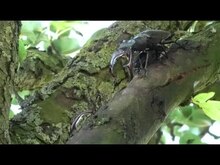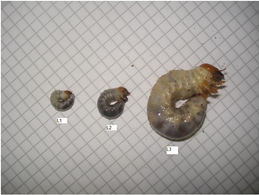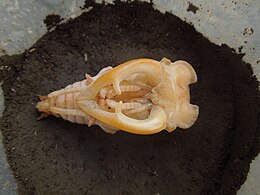Stag beetle
| Stag beetle | ||||||||||||
|---|---|---|---|---|---|---|---|---|---|---|---|---|

Stag beetle ( Lucanus cervus ), ♂ |
||||||||||||
| Systematics | ||||||||||||
|
||||||||||||
| Scientific name | ||||||||||||
| Lucanus cervus | ||||||||||||
| ( Linnaeus , 1758) |
The stag beetle ( Lucanus cervus , from Latin lucanus 'forest dweller' and cervus 'deer') is a beetle from the Schröter family (Lucanidae). It is one of the largest and most conspicuous beetles in Europe . The stag beetle got its name because of the mandibles (upper jaw) that are enlarged like antlers in the males .
The stag beetle is also known as Schröter , Hornschröter , Feuerschröter , Donnergugi or Donnergueg . The name Donnergugi goes back to the nickname Donar of the god Thor . The species was already known in the Roman Empire : the larvae were eaten as a delicacy , the male "antlers" were worn as an amulet .
The stag beetle was insect of the year 2012.
features
Stag beetles are the largest European beetles. The male beetles are usually significantly larger than the female, but there are large fluctuations, especially with the males. Males are about 3.5 to 8 inches long, the females about 3 to 5 inches. They both have a black-brown basic color, the wings are brown-red in color. Females and males, like other species of the genus Lucanus, have bright yellow spots on the front of their fore legs, which are formed by numerous, closely spaced hairs, as can also be seen on the borders between the body sections.
The "antlers" are particularly noticeable on the males. These are the massively enlarged mandibles (upper jaw), which in the males shimmer brown-red. In particularly large specimens, they can make up almost half the body length. The females have a narrower head and normally developed upper jaws.
Occasionally the forma capreolus , also known as hungry males, can be observed, in which the males are very small and, like the females, do not have "antlers". This happens during times of poor nutrition.
Occurrence
The beetles are found in southern , central and western Europe , north to south of Sweden . You can also find them locally in England , Asia Minor and east to Syria . They live in warm, light ( oak ) forests, on sunny forest edges, in different open land areas such as B. orchards, as well as in gardens, parks and avenues of our villages and cities. Stag beetles are successful culture followers. The main flight time in Germany in recent years has been between mid-May and the end of June.
Way of life
Life expectancy
When they first leave the earth, stag beetles are already in their 3rd to 8th year of life. The life expectancy after the beetles hatch is only a few weeks for the males, and the last females also die in late summer. The males in particular are subject to strong predator pressure .
Exercise and diet
Stag beetles can fly and swarm, especially at dusk.
The male can grip his mandibles vigorously, e.g. B. painful one finger; the females can bite harder with their much smaller mandibles. However, the males cannot use their antlers to eat or to bite and chew, they only suck and lick plant juices. The females usually help them to get food by using their mandibles to enlarge wounds on the bark of oaks, which they also lick themselves.
pairing
The females attract their partners with the help of sexual attractants ( pheromones ). If two males meet, they try to throw the opponent on his back with the help of their long mandibles or to pry him off the branch. Only the winner of such a comment fight has the opportunity to mate with the female.
Development of the larva
After mating, the female lays about 20 eggs up to 75 centimeters deep in the ground on the roots of dead or diseased trees. The larvae develop in the roots, trunks and stumps, but need deadwood that has been worn down by fungus , especially oak . Other deciduous trees such as linden , beech , elm , poplar , ash , willow or fruit trees are rarely selected.
Depending on the quality of the wood, the cream-colored larvae usually take three to five, sometimes up to eight years to develop and are often over 11 centimeters long until the last moult. They have a heavily chitinized , light brown head capsule and strong mandibles. They pupate in a fist-sized chamber, about 20 centimeters deep in the ground.
Danger
The stag beetle is listed in Germany's Red List as "critically endangered" (Category 2). It is listed in Appendix II of the European Fauna-Flora-Habitat Directive . This means that national authorities are required to set up special protection areas within the Natura 2000 network to protect the species. Individual protection of all occurrences (as with the species in Appendix IV) is not associated with this.
Its population had declined sharply in Central and Southern Europe . However, this was not because of their popularity for collectors, as is often claimed, but because of the loss of suitable habitats, especially suitable breeding habitats. The rapid change in the landscape in the last century due to the abandonment of intensive, light-producing forms of forest use such as middle forests, hat forests or coppice forests as well as extensive coniferous wood plantings made many forests darker. At the same time, the urban-agricultural area expanded rapidly. Through the development of building land for houses, industrial settlements, road and motorway construction as well as the intensification and expansion of agriculture, orchards, green spaces with trees and forests were mostly lost in line with complete clearing of trees. It has only been seen a little more frequently in recent years. He continues to use the tree stumps offered by people, but now apparently more often in the immediate vicinity of people, i.e. also in gardens, avenues and parks in our villages and cities. The protection of the dead tree stump is often of existential importance for the stag beetle there, and it is precisely this protection that is often denied. On the other hand, the beetles can fly to the necessary juice spots.
Since the construction of the shipyard for the Airbus A380 at Frankfurt Airport required forest areas in which larger stag beetle populations lived, compensation areas were selected for the stag beetle in which the larvae should develop further. For this purpose, around 50 tree stumps suspected of having larvae were dug up in 2005 and reused in other locations near the airport. Because of the long development time of the larvae, the success control dragged on over five years. Ten tree stumps were selected as a random sample, which were protected from wild boars with fences and additionally protected from birds with nets during the hatching period. The counts from 2006 to 2010 showed that beetles hatched from several tree stumps every year. Only one of the ten tree stumps did not give bugs. The implementation action was therefore rated as successful.
literature
- Bernhard Klausnitzer : The stag beetles (Lucanidae). Westarp & Spektrum, Magdeburg, Heidelberg, Berlin and Oxford 1995, ISBN 3-89432-451-1 (Die Neue Brehm-Bücherei Vol. 5).
- Fritz Brechtel, H. Kostenbader (Ed.): The splendor and stag beetles of Baden-Württemberg. 30 tables. Ulmer Verlag, Stuttgart 2002, ISBN 3-8001-3526-4 .
- M. Rink: The stag beetle Lucanus cervus in the cultural landscape: dispersal behavior, habitat use and reproductive biology in the river valley. Dissertation, University of Koblenz-Landau 2006. ( E-Text, PDF )
- Jiří Zahradník , Irmgard Jung, Dieter Jung et al .: Beetles of Central and Northwestern Europe: an identification book for biologists and nature lovers. Parey, Berlin 1985, ISBN 3-490-27118-1 .
- Andreas Schüring: The stag beetle (Lucanus cervus), a rare giant in the beetle kingdom, in: Study Society for Emsländische Regionalgeschichte (Ed.): Emsländische Geschichte 19, Haselünne 2012, pp. 54–60.
- E. Narrator-Uebersax: The stag beetle 'Lucanus cervus' (Coleoptera, Lucanidae) in art and mythology . In: La Terre et la Vie - Revue d'Ecologie . Supplement 10: 153-159. ( PDF ( Memento of December 26, 2012 in the Internet Archive ))
Web links
- Stag beetle search website with the ability to report stag beetle finds
- Stag beetles in Bugman's Käferwelt (private website with many details)
- The Insect of the Year 2012: The Stag Beetle Information leaflet from the Insect of the Year Board of Trustees (PDF)
Individual evidence
- ↑ A profile. In: hirschkaefer-suche.de. Retrieved February 22, 2019 .
- ↑ a b Markus Rink: Habitats. In: www.hirschkaefer-suche.de. Retrieved December 14, 2018 .
- ↑ Markus Rink, Ulrich Sinsch: Habitat preferences of the stag beetle (Lucanus cervus) in the cultural landscape - a method-critical analysis. In: Entomological Journal . No. 116 . Stuttgart 2006, p. 228–234 ( hirschkaefer-suche.de [PDF; 328 kB ; accessed on December 14, 2018]).
- ↑ Federal Agency for Nature Conservation (Ed.): Red List of Endangered Animals in Germany. Landwirtschaftsverlag, Münster 1998, ISBN 978-3-89624-110-8 .
- ↑ Markus Rink: The stag beetle Lucanus cervus in the cultural landscape . Dissertation. Alf 2006, overall discussion, p. 132 ff . ( hirschkaefer-suche.de [PDF; 3.0 MB ; accessed on February 22, 2019]).
- ↑ Where our stag beetles live. In: hirschkaefer-suche.de. Retrieved February 22, 2019 .
- ↑ Airport stag beetle successfully relocated: 7 larvae hatched ( memento from February 22, 2013 in the web archive archive.today ). In: rhein-main.net , May 23, 2006.
- ↑ Jürgen Ebert: Resettlement success of larvae of the stag beetle . In: Nature conservation and landscape planning . No. 03 , 2011 ( nul-online.de [accessed on February 22, 2019]).













